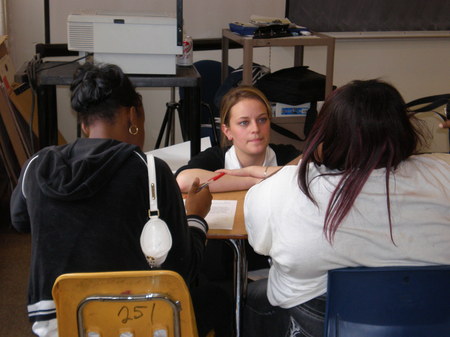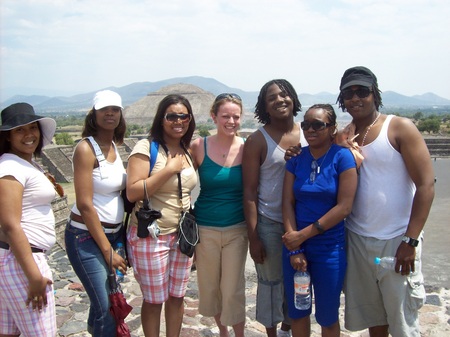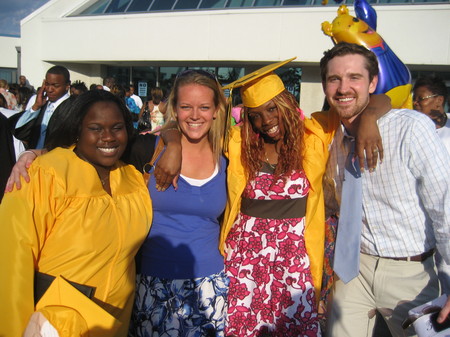| « Election Wrap Up: Mechanics on WBEZ | Election Day with a Long-shot » |
Classroom Mechanics Thu Nov 04 2010
Classroom Mechanics Oral History Project: Lindsey Rohwer

Lindsey Rohwer is a 26-year old Spanish teacher who lives in Lakeview. A native of Omaha, she began teaching in Chicago in 2006 at Corliss High School on the South Side through Teach for America, a non-profit organization that places recent college graduates in schools in low-income communities. Rohwer fulfilled her two-year commitment with Teach for America in 2008 and worked at Corliss for another year. In August 2009, she started a new position as a Spanish I and II teacher at TEAM Englewood Community Academy High School. A few weeks before Rohwer began her second year at TEAM Englewood, I sat down with her at a Starbucks in Bridgeport to discuss her experience teaching and why she remains committed to staying in a classroom beyond her tenure with Teach for America.
I grew up in Omaha, Nebraska. My mom and both my aunts were public school teachers. I grew up in the suburbs of Omaha, and it was a really fantastic school district. So my experience with public school is that it is very high quality, just excellent education from those schools. Then I went to school at the University of Kansas and was a Spanish and International Studies major. I thought I wanted to go to grad school and do foreign policy, sort of more on the politics side of things. During my senior year, I heard a couple of people that had done Teach for America and I started to find out more about it. To be honest it seemed at the time like a good two-year buffer before I actually had to decide what I was really going to do, so that is what drew me to it. I had done tutoring and teaching throughout college, and really enjoyed it, but I did not have an interest in having a career in public education. So it was really like, 'This will be something I will enjoy doing for two years. It will be a challenge.' Then I will go on to do what I really planned to do.
I graduated in May 2006, did a five-week training seminar [in Philadelphia for Teach for America] and moved here in August 2006. After going to the summer institute, where I taught seventh grade reading and math, I just fell in love with [teaching]. I thought it was so wonderful. It was a new thing everyday. It was like you could never predict what was going to happen. You can plan for it, but it keeps you on your toes. So I really liked it.
When I came to Chicago, I was placed at Corliss High School, which is one of the bigger public schools on the South Side. I was a Spanish I and II teacher. I taught mostly seniors and some sophomores and juniors. That first semester, I don't know if some people call it the honeymoon period, it was just wonderful. It could be a challenging or stressful day, and I was more optimistic than I had ever been in my life. It was so energizing and challenging. When I talked to other people that had just graduated about things they were doing right out of college, there was nothing in my mind that compared to the impact that I was able to have just as a 22-year-old right out of college. So I think midway through my first year, I decided I would be teaching for maybe three years instead of the two. Or maybe four or five.
So then I did my second-year at Corliss as well. That year, I fundraised with another teacher about $28,000 to take a group of 13 students to Mexico, so that was really awesome. That was a different side of education not only in the classroom. This was the first time a lot of students had been on a plane, or been out of Chicago, or out of Illinois. Definitely no one had a passport and no one had been out of the country before, so that was really cool.
I finished my two-year commitment [with Teach for America] but then stayed on a third year at Corliss. Then this past year, my fourth year [teaching], I actually switched to TEAM Englewood High School, which is at 63rd and State. They're in their third year. It's a newer school, but it's still CPS. It's in the old Englewood High School building. It was in its third year this year, which was when they added their language requirement. So I was the first World language teacher at this school. I taught Spanish I to all the juniors this year and I'll continue to teach there. At this point, I'm committed to being there in my mind for the next five years or so. And I know whatever I want to do differently in the future, it will always be something with education. I used to think maybe it would be for Teach for America or at the district level, but with the more experiences I've had, I think I really want to be in a school with students. So whatever capacity that's in, that's probably where I will be for the rest of...forever, I guess. [laughs]. I don't have any plans to go anywhere else besides in schools with kids. And especially with the Chicago Public School district. I feel really connected to and committed to increasing the quality of education the students get in CPS.
Both schools [Corliss and TEAM Englewood] are in primarily African-American neighborhoods. Corliss was a little bit more diverse just because it had more students. But out of 1,100 students, there were about 10 to 15 at any given point that were not African-American. And TEAM Englewood is 99.5 percent African-American. In terms of the atmosphere, Corliss is a much bigger school. We have a lot of neighborhood challenges, typically teenage challenges, neighborhood challenges. There are problems you would assume from an urban, big high school. There is gang activity in the neighborhood. CPS, as I'm sure you know, is always in the news for violence with kids and all the stuff that happened at Fenger over the last year. So those were challenges. It was really interesting because I don't think once you know the students at Corliss, that's not ever what you think of primarily. But because it is such a big school and there are so many multiple challenges, it would have been hard for me to sustain the energy I had my first three years if I were to stay there for a long time. Just because with a bigger school there is so much that administrators need to keep track of and they have so many other responsibilities. I think I need a smaller school environment where if there are changes to be made, it's a small staff, it's a small group of students, so you can just make those changes, whereas it's harder to do that at a bigger school.
I think that one thing that any teenager needs is as stable as possible of an environment - consistency in expectation, consistency in consequences for action. At the smaller school level, we have a really, really incredible administration and incredible support system with deans, security, teachers. Everyone at every level is on the same page in what they want to do for kids. With a bigger staff, that wasn't the culture of the staff and it was harder to maintain or monitor the consistency of academic or behavioral expectations for students. At the smaller school level, we have the same problems, but when we notice them, it's easier to say, 'Oh, we're really not being consistent...so let's change that.' [At TEAM Englewood] this year was our third year, so we had freshman, sophomores and juniors. There were about 400 or a little fewer than 400 students. My biggest class was 28, but with that said, I also had a class of 10. In the past, I had classes where the roster started out at 41 or 42. Yes, that got changed throughout the first month as schedule changes were being made, but to have 41 students in a classroom, you cannot get the same results or it's really, really difficult to get the same results. I will have bigger classes [at TEAM Englewood]...as much as our administration prioritizes smaller class sizes because we know that works, it's not fiscally possible to have the same small classes we had last year. That's district, statewide and probably nationwide with what is going on with school districts right now.
One statistic that always stands out to me is that only 1 in 10 students growing up in low-income communities graduates from college. So Teach for America aims to place teachers in schools with the other nine because really it's unimaginable to think of all of the high school students or all of the secondary students in CPS and only less than 10 percent of them graduate from college. Teach for America places teachers in high needs, rural and urban districts, where there is an achievement gap. That looks different for different areas, but definitely in Chicago, that is in Chicago Public Schools and also that means low-income schools and schools with a majority of Latino or African-American population because unfortunately, that generally correlates to low-income communities as well, which is another piece of the puzzle.
I think at [TEAM Englewood] we really help foster that sense of, 'This is your school so if you want something to happen, make it happen.' For example, there were some junior girls who said, 'Next year, we want to have a yoga club.' They didn't know anything about what a yoga club did, but they had the idea. They needed someone to sponsor them and they'll make it work, so it's really cool that students are there not just for their classes from 7:45 to 2:30.
There is this program I have been doing since my second-year called Urban Students Empowered. It is a non-profit organization that takes highly-effective teachers and has them select a group of students in their sophomore/junior year of high school. It's a three-year program, and the goal is that all those students graduate from four-year universities because part of the problem is not just that only 50 percent of CPS student graduate high school. The other problem is if you are a black male, for example, there is a 6 percent chance you will graduate from a four-year university in six years. So the problem is beyond high school. We work with students in their junior/senior year and in their freshman year of college.
The first year it became an organization was my second year of teaching. We started with 10 juniors that year, and me and another Teach for America teacher at my school worked with those students for the past three years. So they just finished their freshman year of college. I think that during experience there have been a lot of ups and downs. There have been incredible successes...We did ACT training. We visited colleges. We had them network with current college students. We really try to provide them just with knowledge others already have about the college application process. We walk them through financial aid. For example, one student came out of junior year, he was one who went to Mexico with me. During one of our first meetings, we asked, 'What do you want to do?'. He said, 'I'm thinking of being a politician, a lawyer and a firefighter. I'd like to be those three things.' I asked him, 'What is your plan?' and there was no understanding of undergrad and then law school, or that you are not going to be able to be all three things together...there was just a huge knowledge gap. Fast-forward three years, and he just finished his freshman year at Morehouse in Atlanta. The impact that he has had on his family, friends and neighborhood, I just really feel like he is a transformative leader.
So that has been really incredible.
Another student came in. She was really quiet and reserved. She had excellent grades, and was really far along academically relative to the other students at Corliss. She came out of her shell and really grew and became invested and became a Gates Millennium Scholar, so her education is paid for forever. She just finished her freshman year at the University of Illinois and was really successful. So there are all these different stories of students who have been really successful. So it's been really incredible to grow with them and develop a really unique and lifelong bond with them and now see them take on that leadership role. I have a group of juniors in same program at TEAM Englewood and we went to the University of Illinois this spring. That student along with the Gates Scholar helped take the students around campus. It's been this really awesome full circle.
All of those wonderful successes happened, but at the same time, of those original students, one got pregnant at the beginning of her senior year and dropped out. She still does not have a high school degree. She still has no plan. Another student finished her senior year and then because of family support and just a whole other host of other things, she never enrolled in college at all. So it's been a year since she graduated and she still has no plan. So it's been hard to try and invest in her and get her on a plan. Another student this year, it was a combination of poor decision making in his freshman year and being at the wrong place at the wrong time. He ended up being arrested, and even though the charges were dropped, he lost his second semester of his freshman year so he is semester behind right now. Alongside those awesome things going on and transformative changes I have been a part of for three years, it also underscores how much work there needs to be done because at same time, there were multiple students that despite all of this additional support, we still fell short of helping them. For me that's the best summation of everything that's happening in CPS and nationwide. Kids are capable of so much and will do so much, and I can do so much with them. But at the same time, that's not enough and I still fell short for those other students. It's not one story of one specific kid, but that provides the dual picture of what's going on.
I believe in public education and I believe that every student should receive a high quality education and I saw that from 0-18, and so I guess I didn't realize how far we fall short on a whole of that. There are pockets of where that is possible, but that's usually in a higher-income community that has smaller class sizes and more money for technology and after school programs. I think [the problem] is also beyond education, beyond school. When I was at Corliss, I would see 18 gas stations or 7-Elevens, but there's not a Wholefoods. The resources in terms of what is available on one side of the city versus the other side of the city is different.
I don't think I could probably stay for very long if I didn't think this was a solvable problem, so part of it is the fact that there is progress being made in my school, in my community, in Chicago in different pockets, nationwide in different pockets. So I don't think you could stay if you didn't see that happening. I do believe it's a solvable problem, and I want to dedicate all the work I do to solving it, and ultimately the motivation has to be students.
I think mostly everyone would say yes, every students deserves a high-quality education, but when you have in your head Chris or Bianca, when you think because of the neighborhood where they were born in, their life paths, their opportunities, they could be drastically different than their peers in high-income communities. You work for those students because that is the reason this is a problem worth solving. Because of those kids, because of all of their potential, all of the successes that students have had, all of the work that still needs to be done. Going back, the fact that I see all those successes motivates me that it is possible and I can't leave until those students who have not had that success do. I don't think I could walk away knowing that there is still so much to be done. Alongside with that is that it's a fun job. Students are fun people and they love learning things and they love having new opportunities. They love talking about college, thinking about college and talking about what they want to do. They are going to be the future leaders of this country. They are going to do really amazing things if we provide them with the tools to be able to do it. So it's exciting work. It's challenging work but it's really fun.
I think that is why I go back to Teach for America, the fact they are recruiting people who might start out in different fields. There has to be a societal shift. The fact that there are all these budget crises nationally and statewide and education is often the first thing to go speaks of national and local priorities. I guess that's also where the second half of Teach for America's mission comes into play. If you have other people in different sectors, I really believe there would be a shift in priority.
I think a teacher also has a responsibility to share how important this work is, and how much attention it deserves and how much more students deserve than what they are currently given. I think that's the same nationally but on a very Chicago specific level. There's so much student potential in the city and we can either foster it or ignore it. And so I think that should be a responsibility that every person feels regardless of how connected they are to education because ultimately, this will be something that affects everyone. That just makes sense to me. There's all this potential and so as humans, we have the obligation to foster it and not ignore it. I think that's a priority that gets lost in the shuffle, which is a huge disappointment and a huge misstep.
This feature is supported in part by a Community News Matters grant from The Chicago Community Trust and the John S. and James L. Knight Foundation. More information here.
Classroom Mechanics is an oral history project aimed at giving voice to teachers around Chicago. For more information, see this post.















Lindsey / November 8, 2010 7:29 AM
If you're interested in making a donation to students from TEAM Englewood who are raising money to travel abroad to Spain this spring, make your donations easily at: https://www.wepay.com/donate/start/137221. All donations are very much appreciated!! --Lindsey